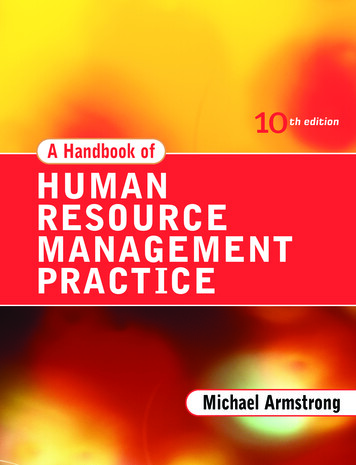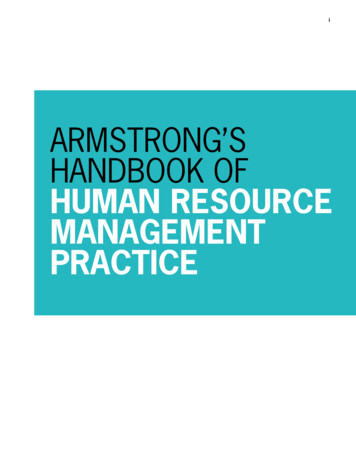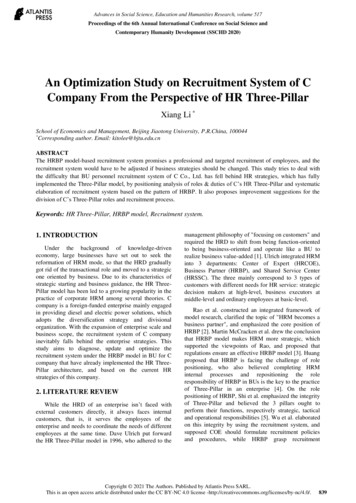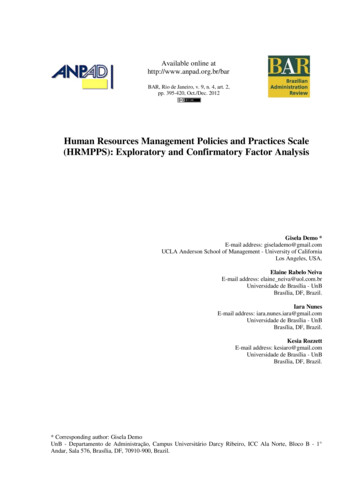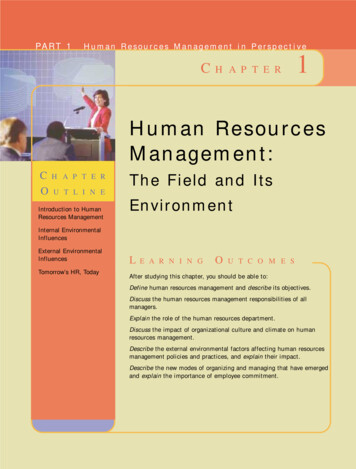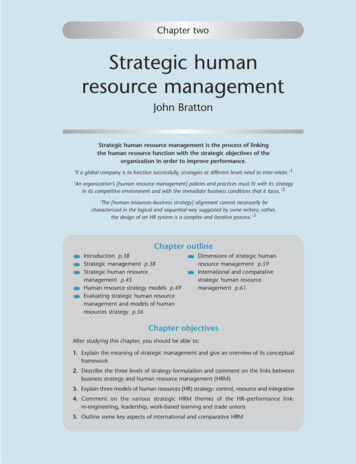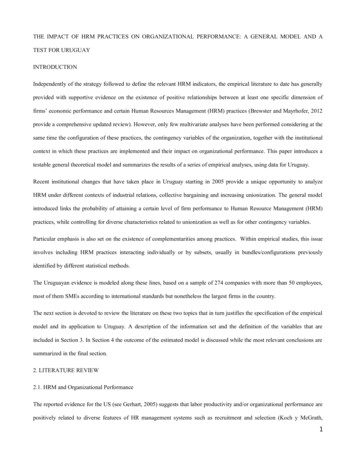
Transcription
THE IMPACT OF HRM PRACTICES ON ORGANIZATIONAL PERFORMANCE: A GENERAL MODEL AND ATEST FOR URUGUAYINTRODUCTIONIndependently of the strategy followed to define the relevant HRM indicators, the empirical literature to date has generallyprovided with supportive evidence on the existence of positive relationships between at least one specific dimension offirms’ economic performance and certain Human Resources Management (HRM) practices (Brewster and Mayrhofer, 2012provide a comprehensive updated review). However, only few multivariate analyses have been performed considering at thesame time the configuration of these practices, the contingency variables of the organization, together with the institutionalcontext in which these practices are implemented and their impact on organizational performance. This paper introduces atestable general theoretical model and summarizes the results of a series of empirical analyses, using data for Uruguay.Recent institutional changes that have taken place in Uruguay starting in 2005 provide a unique opportunity to analyzeHRM under different contexts of industrial relations, collective bargaining and increasing unionization. The general modelintroduced links the probability of attaining a certain level of firm performance to Human Resource Management (HRM)practices, while controlling for diverse characteristics related to unionization as well as for other contingency variables.Particular emphasis is also set on the existence of complementarities among practices. Within empirical studies, this issueinvolves including HRM practices interacting individually or by subsets, usually in bundles/configurations previouslyidentified by different statistical methods.The Uruguayan evidence is modeled along these lines, based on a sample of 274 companies with more than 50 employees,most of them SMEs according to international standards but nonetheless the largest firms in the country.The next section is devoted to review the literature on these two topics that in turn justifies the specification of the empiricalmodel and its application to Uruguay. A description of the information set and the definition of the variables that areincluded in Section 3. In Section 4 the outcome of the estimated model is discussed while the most relevant conclusions aresummarized in the final section.2. LITERATURE REVIEW2.1. HRM and Organizational PerformanceThe reported evidence for the US (see Gerhart, 2005) suggests that labor productivity and/or organizational performance arepositively related to diverse features of HR management systems such as recruitment and selection (Koch y McGrath,1
1996); training programs (Bartel, 1994); performance evaluation (McDonald and Smith, 1995); compensation and benefits(Gerhart and Trevor, 1996; Gómez-Mejía, 1992); and innovative practices (Delaney and Huselid, 1996; Huselid, 1995).Similarly, some research has shown that firms characterized by the use of the above practices outperform those that displayinflexible HR strategies within the same economic sector (Barton, 2004; Black and Lynch, 2001; 2004; Ichniowski et al.,1997; among others), even in the case of small and medium-size units (Way, 2002). Becker and Gerhart (1996), Boxall andPurcell (2003), and Gerhart (2005; 2007a,b) have made comprehensive reviews of the seminal work on the relationshipbetween HRM practices and firm performance as done by Arthur (1994), MacDuffie (1995), and Ichniowski et al. (1997) inmanufacturing and by Batt (2002) in the service sector. Huselid (1995), in turn, conducted an early and influential study thatintroduced the concept of complementarities as applied to HRM practices (Milgrom and Roberts 1990). The existence ofpositive linkages between at least one specific dimension of firms’ economic performance and certain HRM practices hasalso been found in small and medium size units (Way, 2002).From a theoretical point of view, due to its strong emphasis on a subset of these practices that would operate as “bestpractices”, supposedly superior to more traditional ones (and with a theoretical rationale behind it), much of this literaturehas been equated with a “universalistic perspective”. The logic posed assumes that the relationship found can be generalizedto any context, developing a set of ‘High Performance Human Resources Practices’ (HPP) with a progressive impact onorganizational performance (e.g. Delaney and Huselid, 1996). Universalists such as Pfeffer (1995) and Osterman (1994)argue that greater use of “high performance” practices such as participation and empowerment, incentive pay, employmentsecurity, promotion from within the firm, and training and skill development result in higher productivity and profits acrossorganizations.The contingency and configurational approaches, instead, argue that firm performance is dependent on the effectivecombination of some HRM practices and how these practices are “bundled” together in organizations that have distinctcharacteristics. The literature has examined the impact of different bundles on different levels and dimensions of outcomes(Arthur, 1994; MacDuffie, 1995; Ichinowski et al., 1997; Stavrou and Brewster, 2005), in which selected or specific HRMpractices have a consistent configuration that reinforces their impact. These bundles are at times used to define diverse‘work systems’ (Guthrie, 2001; Guest et al., 2003). In some of this literature, though, there is still a “normative tone” onwhat should be the best HR practices (Delery and Doty, 1996; Doty et al. 1993; Martín-Alcázar et al., 2005), as in the preexisting management profiles approach that proposes “ideal types”. In this case, the focus had been set on thecharacterization of management profiles according to the presence/absence of specific practices within the mentionedcategories and on the assumption that they have a differential impact on performance (Druker and White, 1995; Edwards,2
1979; Gowler and Legge, 1986; Labadie, 2005; Monks, 1992; Rodríguez et al., 2003). Delery and Doty (1996) comparepractices within two configurational systems, namely the internal and the market systems. Huselid, Jackson, and Schuler(1997) cite activities such as compensation systems, team-based job designs, flexible workforces, quality improvementpractices, employee empowerment, and planned development of the talent required to implement competitive strategy andachieve operational goals.Ichniowski et al. (1997) explain that when HRM practices are combined in different forms, the effects on organizationalperformance are much greater than when practices are explored individually. In fact, MacDuffie (1995) argues that theappropriate unit of analysis for studying the strategic link between different HRM practices to performance does not involveindividual activities as much as interrelated and internally consistent practices, called “bundles.” He explains that a“bundle” creates the multiple, reinforcing conditions that support employee motivation. Along the same lines ofargumentation, Perry-Smith and Blum (2000) suggest that HR bundles capture broader and higher-level effects than thosecaptured by focusing on individual policies and are particularly appropriate for investigating firm-level effects.A strand of this literature has argued that the relevant configurations of practices vary across organizations depending onseveral dimensions, the focus being mostly set on divergences in management and distinct competitive advantages, that arein turn mirrored in different organizational strategies (a brief recent discussion on the topic can be found in Brewster, 2007).Schuler and Jackson (1987) distinguish among organizational strategies founded on either cost reduction, qualityimprovement or innovation activities. The authors argue that employees are required to play different roles depending onthe type of strategy and thus the best HR practices would be those that are most suitable to serve the purpose. 1HR managerial strategies displayed by firms seeking to improve organizational performance have been classified in twobroad types depending on their intrinsic character being oriented towards the increase of human resources’ skill-levels orelse of the degree of involvement of workers in the organizational strategy and the performance of the firm. These twocategories are discussed in the literature under different denominations, such as ‘control’ and ‘commitment-oriented’practices (Walton, 1985); ‘efficiency’ and ‘strategy’ related HRM activities (Fombrun et al., 1984); or ‘calculative’ and‘collaborative’ HR practices (Gooderham et al., 1999). The subsets of practices with the highest weight in a particularbundle built by Factor Analysis are generally of either one type or the other and thus the corresponding bundle is classifiedin accordance. However, it is at times the case that the bundle has a mixed and/or ambiguous character due to the fact that1For example, non-professional recruitment and selection methods may be optimal for firms with competitive advantages stemming froman efficient management of costs, even at the expense of the quality of the goods and services supplied. In contrast, skilled workers thatare highly committed to the firm would fit a strategy rooted on continuous improvement and innovation activities and may hence requirethe use of professionalized and strategically-oriented hiring practices.3
efficiency and strategically oriented HRM activities are both key components of the resulting construct. Gooderham et al.(2008) propose to denote these configurations as ‘intermediary’ bundles.Bundles that are usually found to be relevant are: selective recruitment, training and incentive pay, both of a calculative andcollaborative nature (e.g., Black et al., 2003; Galia, 2006; Gooderham et al., 2008; Huselid, 1995; Ichinowski et al.,1997;Katou, 2008; Stavrou and Brewster, 2005). Evaluation systems, both aimed at rewarding performance and or trainingmonitoring, are also frequently found to be relevant (e.g., Galia, 2006; Gooderham et al., 2008; Huselid, 1995; MacDuffie,1995; Stavrou and Brewster, 2005); team-working (e.g., Galia, 2006; MacDuffie, 1995); as well as management-workforcecooperation, shared values, communication and other features that should improve commitment of workers to theorganization (e.g., Huselid, 1995; Katou, 2008; MacDuffie, 1995).International evidence supports the existence of positive linkages between most of these HRM bundles and organizationalperformance (Brewster and Mayrhofer, 2012). Research also suggests that improvements in performance are associated tothe use of several of the single practices within these bundles, such as those related to skill and cognitive recruitment,training or incentive pay (e.g., Beer et al., 1985; Black and Lynch, 2001; Delaney and Huselid, 1996; Fombrun et al., 1984;Guest et al., 2003; Guthrie, 2001; Jackson and Schuler, 2000; Walton, 1985). 2 High-commitment HR practices identified asdrivers of performance include selection and training activities that emphasize values and human relations; behaviour-basedpromotion and rewarding; contingent pay systems; wages set above their market-level; among others (Lengnick-Hall et al.,2009).However, much of the existing empirical evidence on the actual adoption levels of HRM, as Godard (2004, pp. 6)convincingly argues, shows that many workplaces in effect combine a number of traditional personnel practices coupledwith intermediate levels of adoption of HPPs and none of these studies can fully account as to why most employers wouldsettle on the partial adoption of some of these high-level HPPs. It is recognizing that the significant gains they yield couldbe partially offset by their associated costs, that are rarely reflected in the performance measures used by researchers(Cappelli and Neumark 2001: 743) that some light can be shed. These costs, in turn, are strongly dependant on certain firmcharacteristics and its environment as argued in Godard (2004, pp. 20) and in particular in the role played by unions.The degree of influence of unions at the firm has indeed been analyzed as an additional contingent dimension (e.g., byBrewster, 1995), that has at times been considered jointly with the organizational strategy (e.g., in Gooderham et al., 2008).The topic is usually examined in the industrial relations literature in terms of either “the union substitution effect” or the2An extensive review of this literature can be found in Boselie, Paauwe and Jansen (2001).4
“mutual gains” hypotheses, with some consensus within the literature that High Performance HRM practices would operateas a substitute to unions (Kochan, 1980). Under that frame, powerful or militant unions with a poor relationship withmanagement are likely to have a negative impact on the adoption of ‘High Performance HR Practices’ (HPP), at the extentthat organizations characterized by large union militancy might exhibit a significantly lower likelihood of undertaking anyHPP (Wells, 1993). However, the assumption has little empirical support except in the case of activities related to pay andcommunication methods that give direct voice to workers (Godard, 2009; Machin and Wood, 2005), or the use of ‘word ofmouth’ as a recruitment source that has become a prominent practice in unionized frameworks, as is the case of India(Budhwar & Khatri, 2002). Some authors have argued that the implementation of some HR practices may in contrastgenerate a “mutual gain” with unions playing a more partnership-oriented role instead of their traditional adversarialpositioning (see the review in Gill, 2009).The contingent character of management has been also associated to other organizational characteristics, such as the firm’seconomic activity (e.g., in Bloom and Van Reenen, 2007); sales market (e.g., in Osterman, 1994); societal form (e.g., inRajan and Wulf, 2006); size (e.g., in Jackson and Schuler, 1995); and ownership (with respect to its family/non-familynature, as in Bertrand and Schoar, 2006, or its national/multinational character, as in Bloom et al., 2009). Further, firm size,industry, the presence of unions, labor-management conflicts, and bureaucratic hiring and termination procedures all appearto have some relationship with external labor arrangements (Masters and Miles, 2002).Small organizations and family businesses are more likely to operate in an informal and flexible manner than larger firms,replicating these patterns in HRM practices (Bacon et al., 1996; Koch and McGrath, 1996). The national/multinationalcharacter of firms is also considered as a differential feature (Kostova and Roth, 2002; Gómez and Sánchez, 2005).Given the above, the universalist view on the role of HR management and the optimality of specific practices in terms offirm performance seems to be strongly questioned as a suitable explanation of actual trends in the US, Canada, England andsome European countries. However, no generalization whatsoever can be made for Latin American countries, for which thelack of knowledge and quantitative studies is critical, even at the basic descriptive level. Very limited valid empiricalresearch has been published, with the exception of Elvira and Davila (2005) and Davila and Elvira (2009), who compilecases and narratives of HRM practices in the region, but no quantitative empirical test.Given the scant knowledge on Latin America, a general multivariate model is herein introduced, that stylizes therelationships among these constructs, depicted in Figure 1. As a general specification, it allows to provide valid tests andanswers to research questions such as:5
1)2)3)4)5)6)7)8)9)What is the impact of unions on organizational performance when controlling for HRM practices ?Are there complementarities among HRM practices?Are there complementarities among different bundles of HRM practices?Are there “complementarities” or “substitution” effects among HRM and Unions?Do these effects differ depending on the type of HRM practice (calculative or collaborative)?Do these effects differ depending on the levels of Union influence?How do they change when union influence changes?Do they differ by type of performance indicator?Do they differ by levels of institutionalization of collective agreements?Figure 1. GENERAL MODEL OF HRM PRACTICES AND ORGANIZATIONAL PERFORMANCEAs part of a research agenda, this model can be tested with evidence from Uruguay. The new labor relations setting andhigher union influence at the societal level described in the next section, not only provides an interesting Latin Americancase but it also constitutes a unique “statistical experiment” to test some of the traditional hypotheses that link HRM andunions. These relationships have been traditionally tested –for more developed countries- in a particular context ofunionization or at best comparing patterns between countries with different degrees of union influence. Instead, the case ofUruguay allows a test for the same set of firms in two distinct scenarios of unionization and collective bargaining6
mechanisms -a period of declining union density with firm-level negotiations and a period of increasing union power withmandatory sector level collective bargaining.Preliminary answers to the above research questions have been provided by using multivariate models have been alreadypresented elsewhere, indicating the relevance of complementarities, the importance of distinguishing between calculativeand cooperative bundles to model the relationship to union behavior and organizational strategy, but the estimation of thefull model poses some methodological limitations imposed by the Uruguayan sample size, briefly referred in the nextsection.2.2 The Uruguayan Case2.2.1. HRM practicesAlthough the empirical research on HRM in Uruguay is still very scant, it has nonetheless brought forth the existence ofseveral regularities. A first worthy finding refers to the apparent progressive professionalization of HRM practices amongmedium and large firms that took place along the last two decades, the drivers of such trend not being yet clearly identified(Font, 2010; Labadie, 2005). The heterogeneity of HRM practices reported in Font (2010) for 2007 is in sharp contrast tothe ‘simple management profile’ that prevailed in the 1990s, even among the largest companies, characterized by employeremployees relations aimed at short-run goals; infrequently observed formal systems of performance-evaluation; andadministrative/bureaucratic HR departments (Labadie, 2005; Rodríguez-Gustá et al., 2003).According to these studies, the most widespread practices, both currently and in the past, are related to recruitment andtraining, as opposed to the use of monetary premia based on individual/team performance or sophisticated performanceevaluation systems. However, the patterns differ among firms depending on several features, such as family, national orcorporate ownership; size; sales market; and economic sector; while it also depends on the firm having or not a HRdepartment. A higher degree of formality and professionalism of HRM is found among large corporations, non-familyowned firms that have a formal HR division, operating in the service sector and/or oriented to the international market(Rodriguez-Gustá et al. 2003; Font, 2010).The relationship between economic/organizational performance and HRM has been explored by Font (2010) and by theauthors of this paper (references available) using two distinct methodologies. Measured as the self-ranking relative to itscompetitors in terms of profitability; labor productivity; and quality of the products/services, firm performance is examinedin relation to individual HRM practices (recruitment; training; performance evaluation; and monetary payments). Fontfurther considers several additional features that are grouped using factor analysis to build indicators of ‘best practices’ and7
despite the general conclusion points at professional HRM being matched to an improved firm economic/organizationalperformance, the four configurations obtained cannot be unambiguously ordered in terms of ‘best practices’, except forfirms in the cluster denoted as ‘low-profile’.Previously, Labadie (2005) had hypothesized that the linkages between HRM practices and performance are influenced bythe overall institutional framework of labor relations and particularly by the role played by HR departments in relation totrade unions. The additional insights provided in Font (2010) also point in that direction while they further suggest that thestructure of bargaining and its continuity in time have also a major incidence.2.2.2. HRM and Industrial relations in UruguayMajor institutional changes have characterized the industrial relations system in Uruguay. Starting in 1985 Uruguay sunique system of Wage Councils was re-instituted after almost 15 years along which collective bargaining was absent giventhat the 1973 military coup had banned unions. The traditional system operated mainly through a system of trilateralnegotiations – unions, employers representatives and government - within wage councils by industry. Minimum wages byjob category were set through collective agreements and endorsed by the government to all firms within the sector. Thesystem implied that for most SMEs the level and timing of wage setting were located outside the boundaries of firmdecision-making, by the negotiators of the larger companies that were represented in the employers associations (seefurther details in Cassoni et al., 2004). Along these lines, the HR department was only strategically relevant for those largefirms with powerful unions that frequently operated in concentrated sectors (Labadie, 2005). Unions, in turn, were almostexclusively interested in setting wage levels, in accordance with the intermediate degree of centralization of the system andthe highly inflationary entourage. This was particularly the case of the manufacturing sector, which in 1985 employedalmost half the labor force in the private sector, of which one third were union members (Cassoni et al., 2004).In 1991 there was a significant change. The government stopped participating in bargaining and hence collectiveagreements bound only those firms and unions that were actually represented in the negotiation. As a result, union densitywithin the private sector dropped sharply and many agreements started to be bargained at the firm level (for details on thesechanges and their effects on the labor market regarding employment, mobility, wages, as well as on firm economicperformance, investment and profitability, see Cassoni et al., 1996; 2000; 2004; 2005).In 2005, with the advent of a newly elected government, the traditional tripartite industry-level negotiation system was reinstituted, while compulsory bargaining was also extended to all services, commerce, rural workers and activities with atraditionally high informality degree. As a result, the number of firms that set wages internally decreased sharply. Union8
membership increased about 40% between 1997 and 2007 further fueled by the prevailing context of sustained economicgrowth, employment formalization and wage increases after the 2002-economic crisis, one of the most significant in thehistory of Uruguay (Bianchi et al., 2011).The joint analysis of the hypotheses summarized in Figure 1 and the answers to the research questions posed in the previoussection has been attempted in previous studies (reference withdrawn to secure blind review) given the advantages of theseinstitutional changes in Uruguay. However, the estimation can only be robust if performed using a large-sized sample sothat the degrees of freedom are still sufficient to validate the statistical inference. Further, the high collinearity that isintroduced among regressors also generates increases in the variance of estimates that may prevent the identification ofactual effects. The use of bundled practices poses additional methodological challenges linked to the introduction ofendogeneity biases, forcing the use of full-information estimation methods that further reduce the degrees of freedom.Therefore, the full analysis of all the hypothesized effects has to be undertaken sequentially.In this paper we thus focus on the identification of significant bundles of practices and on the quantification of their impacton firm performance, as measured by labor productivity. We also include individual practices seeking to contribute to thediscussion on their merit relative to that of configurations as productivity drivers. In doing so, and following the proposedmodel, we control for diverse firm characteristics, the main strategy that is the source of the firm’s competitive advantage;and the degree of union influence and its evolution with respect to 2004.3. DATA, DEFINITION OF VARIABLES AND BUNDLESThe information used stems from the “Survey on Labor Relations and HRM Practices” (SLR), performed in 2007 to asample of 274 medium and large enterprises, representative of the universe of 1172 firms with 50 and more workers thatbelong to Industry; Construction; Commerce; and Services. 3 The sample was selected through a stratified (economic sectorand size) sampling model. The data relate to a wide range of HRM practices, many of which are also referred to 1999-2001,and other operational characteristics of the firm, its main sales market and the current and past institutional setting of laborrelations.3“Encuesta de Relaciones Laborales y Prácticas de Recursos Humanos a nivel de Empresa”, Universidad ORT Uruguay - EquiposMori, 2007.9
Data were collected using the CRANET questionnaire through personal interviews. 4 The answers provided by therespondents allow for defining binary indicators that state if a HRM practice is used or not by the firm or else categoricalvariables that differentiate between the intensity with which a practice is used within a 5-value likert scale (where 1corresponds to the absence of the HRM activity and 5 to its permanent use). Given the subjective nature of the survey, itwas decided not to differentiate between degrees of intensity that correspond to the two top/bottom strata (that mayintroduce distortions into the analysis as shown by Fowler, 2009 and by Kanouze and Elliot, 2010). Hence, the originalvariables become categorical with 3 possible values instead of 5.The resulting indicators reflect the degree of usage of 130 individual HRM practices. In many cases, however, the sameHRM activity gives rise to four different individual practices, one for each type of employee – managers; technicians andprofessionals; administrative staff; and blue-collar workers. Practices are classified in 7 subsets that match particulardimensions of management – hiring (recruitment sources, selection profile sought, selection methods); training (withdifferent goals); performance evaluation (aimed at distinct objectives); pay (wage setting mechanisms, regular benefitslinked to diverse aspects and contingent extraordinary premia); communication flows and channels (collective and/orindividual, involving employees in different occupations and referred to distinct topics); formalization/organizationalculture (the existence of unwritten/written statements on eight organizational aspects); and organizational characteristics ofHRM (the existence and type of HR department; the qualification and roles of HR managers; and the degree of outsourcingof practices). Practices are further re-defined by jointly considering those with a shared character (e.g., recruitment throughadvertisements in newspapers or web pages, public pools or among unsolicited workers give rise to a unique HRM activity)and also by ignoring differences by type of worker. The definite set involves 71 HRM practices (Table 1).Factor Analysis is performed over different sets of practices controlling for sample design effects to avoid the introductionof biases (Fazio et al., 2008). Significant factors (that are therefore kept) are those with an associated eigenvalue that is notbelow 1. These factors are afterwards transformed into orthogonal constructs using the Varimax method. 5 The use of the redefined set of HRM activities together with those single practices for which the previously estimated loadings differ4The CRANET questionnaire has been developed by an international team of scholars doing research on human resource managementover the past 15 years (see Brewster, Mayrhofer and Morley, 2004 for details on the questionnaire and its methodology). Thequestionnaire is structured with eighty composite closed-ended questions, each of which presents a number of options/items, attemptingto cover all facets of HR management. The unit of analysis of the questionnaire is the organization and the respondent is the highestranking corporate officer in charge of human resource management. Besides the regular CRANET questionnaire validated in Spanish, anadditional module added questions on HRM and union practices in 1999-2001.5These analyses are reported in working papers whose citation is withdrawn to secure the blind review process. They are available uponrequest and available on the web. The analysis is first performed over all original practices (130) and 29 significant factors are identifiedthat account for 84% of the total variance. Most of them (26) are just a grouping of the same practice referred to each of the fouroccupational types considered. We therefore perform a robustness check by factor analyzing practices within each of the 7 above-listedHRM dimensions and obtain fully consistent constructs. In both cases, the total number of identified bundles is too large if they are to beincluded in a multivariate model for firm performance.10
substantially, leads to the identification of 15 significant constructs that account for 84% of the total variance and that aregenerally consistent with those obtained using the original set of practices, although wi
performance are much greater than when practices are explored individually. In fact, MacDuffie (1995) argues that the appropriate unit of analysis for studying the strategic link between different HRM practices to performance does not involve individual activities as much as interrelated and internally consistent practices, called "bundles."


